Do you have a question about the M-Audio Duo and is the answer not in the manual?
Lists the items included in the Duo package.
Outlines the initial steps for setting up and using the Duo.
Details the technical performance metrics of the Duo, such as dynamic range and THD+N.
Specifies the necessary hardware and software configurations for PC and Mac.
Explains the function of the line level input switch and pad switches on the front panel.
Describes the gain controls and the signal/clip indicator LEDs for each input.
Details the standalone mode switch, headphone output jack, and headphone level control.
Covers the main power switch and the phantom power switch with their respective LEDs.
Identifies the power input jack and the USB connector for system connection.
Describes the S/PDIF output, line outputs, and the line level output switch.
Explains the line inputs and microphone inputs on the back panel.
Details how to set the sample rate using DIP switches when the unit is in standalone mode.
Step-by-step guide for installing Duo drivers and software on Windows XP.
Step-by-step guide for installing Duo drivers and software on Windows 2000.
Step-by-step guide for installing Duo drivers and software on Windows ME.
Step-by-step guide for installing Duo drivers and software on Windows 98 SE.
Instructions for installing the Duo's ASIO driver and related components on a Mac.
Guidance on connecting microphones, line-level instruments, and monitoring systems to the Duo.
Explains how to adjust the line level for inputs and outputs for compatibility.
How to use the control panel to select ASIO/EASI or MME drivers for PC operation.
Configuring the Duo to work with the Windows Sound System for general audio playback.
Using the Duo with music software that supports MME drivers.
Accessing and configuring the Duo's ASIO/EASI driver settings on a PC.
Details available channel sets, bitwidth, and sample rates in the ASIO control panel.
Explains how channel selection and bit depth affect available sample rates, including 96kHz.
Configuring the Duo to use the Mac's built-in Sound Manager for audio.
Adjusting advanced settings like thread priority and optimizing for slower systems.
Explains how channel selection and bit depth affect bandwidth and sample rate on Mac.
Provides advice on improving audio performance by optimizing system settings and hardware.
Addresses common problems like no audio output or driver error messages.
Helps diagnose and resolve ticking sounds potentially caused by USB interference.
Guides users to find information through M-Audio's read-me files and website.
Lists the information needed to provide to technical support for efficient troubleshooting.
Lists the items included in the Duo package.
Outlines the initial steps for setting up and using the Duo.
Details the technical performance metrics of the Duo, such as dynamic range and THD+N.
Specifies the necessary hardware and software configurations for PC and Mac.
Explains the function of the line level input switch and pad switches on the front panel.
Describes the gain controls and the signal/clip indicator LEDs for each input.
Details the standalone mode switch, headphone output jack, and headphone level control.
Covers the main power switch and the phantom power switch with their respective LEDs.
Identifies the power input jack and the USB connector for system connection.
Describes the S/PDIF output, line outputs, and the line level output switch.
Explains the line inputs and microphone inputs on the back panel.
Details how to set the sample rate using DIP switches when the unit is in standalone mode.
Step-by-step guide for installing Duo drivers and software on Windows XP.
Step-by-step guide for installing Duo drivers and software on Windows 2000.
Step-by-step guide for installing Duo drivers and software on Windows ME.
Step-by-step guide for installing Duo drivers and software on Windows 98 SE.
Instructions for installing the Duo's ASIO driver and related components on a Mac.
Guidance on connecting microphones, line-level instruments, and monitoring systems to the Duo.
Explains how to adjust the line level for inputs and outputs for compatibility.
How to use the control panel to select ASIO/EASI or MME drivers for PC operation.
Configuring the Duo to work with the Windows Sound System for general audio playback.
Using the Duo with music software that supports MME drivers.
Accessing and configuring the Duo's ASIO/EASI driver settings on a PC.
Details available channel sets, bitwidth, and sample rates in the ASIO control panel.
Explains how channel selection and bit depth affect available sample rates, including 96kHz.
Configuring the Duo to use the Mac's built-in Sound Manager for audio.
Adjusting advanced settings like thread priority and optimizing for slower systems.
Explains how channel selection and bit depth affect bandwidth and sample rate on Mac.
Provides advice on improving audio performance by optimizing system settings and hardware.
Addresses common problems like no audio output or driver error messages.
Helps diagnose and resolve ticking sounds potentially caused by USB interference.
Guides users to find information through M-Audio's read-me files and website.
Lists the information needed to provide to technical support for efficient troubleshooting.
| Type | Audio Interface |
|---|---|
| Channels | 2 |
| Outputs | 2 x 1/4" TRS |
| MIDI I/O | No |
| Phantom Power | Yes |
| Headphone Output | 1 x 1/4" TRS |
| Frequency Response | 20 Hz - 20 kHz |
| Inputs | 2 x XLR-1/4" combo |
| Signal-to-Noise Ratio | 100dB |
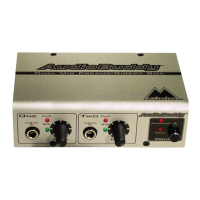
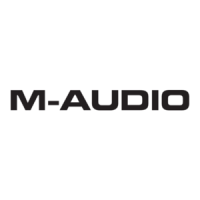
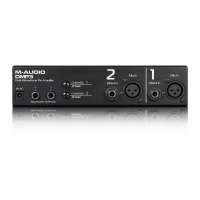
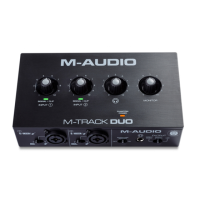
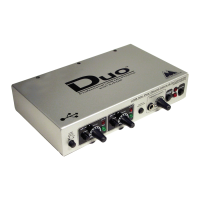
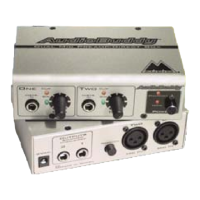
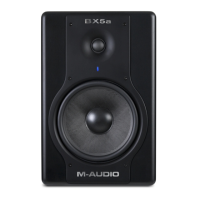
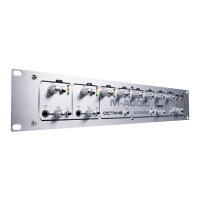
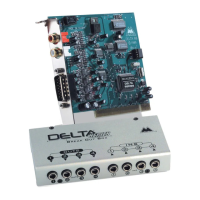
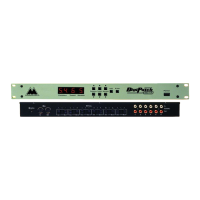
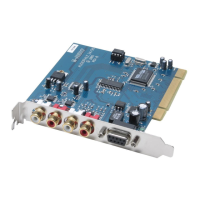
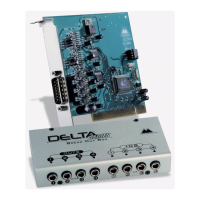
